Copper Melting Furnace
SuperbMelt induction furnace for copper melting (80-250KG melting capacity)
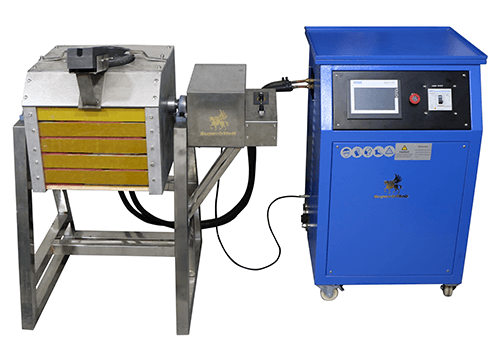
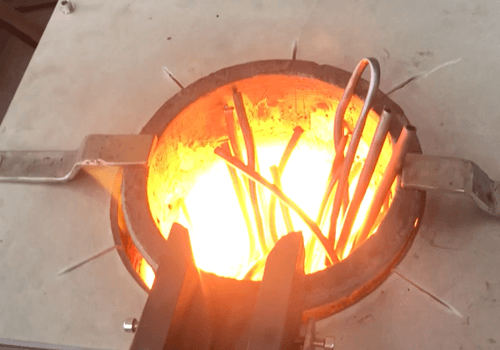
SuperbMelt Fantastic Melt Induction 80 to 250 kilogrammes of copper, gold, silver and other metals can be melted at once in a copper melting furnace.
The electric tilting melting furnace is made to be operated by a single person.A steel frame holds the main body of the tts. The furnace can be tilted in any direction with manual control.
Its distinguishing qualities include small footprint, quick melting, and energy conservation. This is the most economical option for casting metal in small quantities.
Power Supply Parameters for Motorized Inclined Copper Melting Furnace
| Model | MTF-15 | MTF-25 | MTF-35 | MTF-45 | MTF-70 | MTF-90 | MTF-110 | MTF-160 | |
| MAX input power | 15KW | 25KW | 35KW | 45KW | 70KW | 90KW | 110KW | 160KW | |
| MAX input current | 23A | 36A | 51A | 68A | 105A | 135A | 168A | 240A | |
| Input voltage | Three-phase 340V ~420V 50/60Hz | ||||||||
| Oscillation frequency | 1K~20KHz | ||||||||
| Requirement of cooling water | Hydraulic pressure | ≥0.2Mpa | ≥0.3Mpa | ||||||
| Flow rate | ≥6L/Min | ≥20L/Min | |||||||
| Temperature of water | ≤45℃ | ||||||||
| Generator box | Weight | 28kg | 29kg | 52kg | 52kg | 57kg | 91kg | 99kg | 134kg |
| Volume | 51×28×49cm | 65×35×58 | 78×40×88 | 78×50×88 | |||||
| Transformer box | Weight | 35kg | 35kg | 35kg | 38kg | 52kg | 68kg | 95kg | 95kg |
| Volume | 62×30×53cm | 64×48×58 | 64×65×61 | ||||||
Melting Capacity Parameter of Tilting Metal Melting Furnace
| Model | Fe, ss | Cu, Au, Ag | Al, Al-alloy | Model | Fe, ss | Cu, Au, Ag | Al, Al-alloy | |
| MTF-15 | 3kg | 10kg | 3kg | MTF-70 | 25kg | 80kg | 25kg | |
| MTF-25 | 5kg | 20kg | 5kg | MTF-90 | 40kg | 120kg | 40kg | |
| MTF-35 | 10kg | 30kg | 10kg | MTF-110 | 50kg | 150kg | 50kg | |
| MTF-45 | 18kg | 50kg | 18kg | MTF-160 | 100kg | 250kg | 100kg | |
| Remark: Above melting capacity sheet for general reference; Melting duration: When the crucible is hot,20~30min./workload; When the crucible is cold(first melt),40~50min./ workload. | ||||||||
- High-Temperature Capability: Due to copper’s high melting point, a metal furnace needs to have a high-temperature heating capacity to ensure it can reach a sufficient temperature for melting copper. The SuperbMelt metal furnace is equipped with high-powered heating elements to meet this requirement.
- Temperature Control Precision: Since copper is susceptible to oxidation, precise temperature control is crucial. This can be achieved through a digital control system to ensure the maintenance of the appropriate inert atmosphere to reduce oxidation during the melting process.
- High Efficiency: To enhance production efficiency, a copper furnace should have features for rapid heating and uniform heat distribution, reducing the melting cycle and increasing output.
- Metal Recovery: SuperbMelt induction furnaces are equipped with a waste heat recovery system to minimize resource wastage. This is essential for recycling and reusing copper, contributing to environmental protection and cost control.
- Versatility: Considering copper’s various applications, SuperbMelt induction furnaces offer versatility to meet the needs of different industries. This can be achieved by adjusting operational parameters or using different melting molds.
- Safety: Safety is paramount when operating a metal furnace, especially in high-temperature environments. Adequate safety measures such as thermal protection and operational guidelines must be implemented to ensure the safety of personnel.
Why SuperbMelt induction furnace for copper melting



Any Question About SuperbMelt Electric Furnace Melting Copper

2 years warranty
The warranty for our machine is one year longer than the warranty provided by other factories.

Strong service team
We will give response within 24 hours against your problem by our professional engineer.
Guide to Induction Copper Melting Furnaces
Where does copper come from?
The primary source of copper is copper ore, a naturally occurring mineral deposit found in the Earth’s crust. Chalcopyrite, commonly referred to as copper pyrite, and bornite are two of the most prevalent copper ores. These ores contain different copper compounds or oxides.
Mining and extraction are often involved in the acquisition of copper. Crushing, grinding, and concentration are some of the procedures used to separate the copper minerals from other rock and mineral components once the copper ore has been taken from the mine.
1.1, Copper ore mining
Copper ore mining is the process of extracting copper-bearing minerals or ores from the Earth’s crust for further processing and refinement. Copper is one of the most commonly mined metals due to its wide range of industrial applications. The process of copper ore mining typically involves several stages:
- Exploration: Geologists and mining experts conduct surveys and exploration activities to identify potential copper ore deposits. This includes geological mapping, sampling, and drilling to assess the quality, quantity, and location of copper-bearing rocks.
- Mine Development: Once a viable copper ore deposit is identified, a mine is developed. This involves building infrastructure such as access roads, tunnels, and shafts to access the ore underground.
- Drilling and Blasting: To extract the copper ore from the Earth, drilling and blasting techniques are commonly used. Holes are drilled into the ore body, explosives are inserted, and controlled explosions break the rock into smaller pieces.
- Ore Extraction: The broken copper ore is then extracted from the mine. Different mining methods may be employed based on factors like ore depth and deposit size. Common methods include underground mining and open-pit mining.
- Ore Processing: Once extracted, the copper ore may require additional processing to separate the valuable copper minerals from the surrounding rock and impurities. This can involve crushing, grinding, and various beneficiation processes.
- Transport and Haulage: Processed copper ore is transported to processing facilities or smelters, often using trucks, conveyor belts, or other transportation methods.
- Smelting or Refining: At processing plants or smelters, copper ores are subjected to smelting or refining processes to extract the pure copper metal. Smelting involves heating the ore to high temperatures to separate the copper from impurities.
- Environmental Management: Responsible mining practices include environmental management to minimize the impact of mining activities. This includes measures to prevent soil erosion, control water pollution, and mitigate habitat disruption.
- Waste Management: Managing waste materials generated during mining, such as tailings (waste rock and mineral residue), is a crucial aspect of sustainable mining.
- Reclamation and Closure: After the mining operations are complete, mine sites are often reclaimed and restored to their natural state or repurposed for other uses. Closure plans ensure the long-term environmental and safety management of the site.
Copper ore mining is a significant industry worldwide, and it provides essential raw materials for various sectors, including construction, electronics, transportation, and energy. Responsible mining practices aim to balance the economic benefits of mining with environmental and social considerations.
1.2, Smelt metal
High temperatures are employed during the smelting process to separate the metal from its ore or other basic materials. Smelting removes impurities and other non-metallic components from the metal in the ore, leaving behind a more pure metal. Depending on the type of metal and ore being treated, different smelting processes may entail different particular procedures. The general procedures for melting metal are as follows:
- Getting the ore containing the metal you want to remove is the first step in the smelting process. The ore may need to be crushed, ground, or otherwise processed in order to make it acceptable for smelting. Ore is frequently mined from the Earth’s crust.
- Roasting (Optional): The ore may occasionally be roasted, which involves heating it in the presence of air to get rid of some impurities or alter the chemical makeup of the ore. A dedicated furnace or kiln can be used for roasting.
- Smelting Furnace: A smelting furnace is used to melt the prepared ore. Depending on the metal being smelted, a different type of furnace may be employed. Blast furnaces, reverberatory furnaces, and electric arc furnaces are examples of common furnace types.
- Heating: The furnace is heated to high temperatures that are frequently higher than the metal’s melting point. The metal in the ore melts at the tremendous heat and separates from other materials.
- Separation: Slag, or impurities, which float to the top during the smelting process can be skimmed off. At the furnace’s base, the molten metal that has been cleansed gathers.
- Casting: The metal is cast into moulds to produce the required shape or form after it has been thoroughly melted and cleaned. For additional processing, the metal may be cast into ingots, bars, or other shapes.
- Cooling: Solidification of the cast metal occurs after cooling. To attain particular qualities in the finished metal product, the cooling process might be manipulated.
- Additional Processing: To shape and refine the metal, additional processing procedures like rolling, forging, or machining may be carried out, depending on the intended application of the metal.
- Quality Control: To make sure the metal satisfies particular requirements for purity, strength, and other qualities, quality control procedures are frequently used.
In order to produce different metals, such as iron, copper, aluminium, and others, smelting is an essential process. It is a crucial component of the metallurgical sector and is used to make a variety of goods for the building, manufacturing, and other sectors of the economy.
1.3, Modern application
Copper is still a crucial component in modern engineering. It is utilised in many different industries, including electronics, electrical engineering, building, transportation, healthcare, and defence technologies. Copper is the chosen material for electrical parts, cables, and motors due to its conductivity and temperature characteristics.
The Applications of Copper
- Electronics: Wiring and components.
- Construction: Pipes, roofing, and facades.
- Transportation: Automobiles and aircraft.
- Medical Equipment: Instruments and devices.
- Military Technology: Munitions and equipment.
- Jewelry: Rings, bracelets, and more.
- Artistic Sculptures: Statues and figurines.
- Home Decor: Vases, lamps, and bowls.
- Cookware: Pots, pans, and utensils.
- Architectural Details: Roofs and facades.
2.1, Art and Decorative Items
- Copper is a popular choice for creating sculptures and artistic pieces due to its malleability and ability to hold intricate shapes. Artists often use copper to craft sculptures, statues, and figurines that are both visually appealing and durable.
- Unique Appearance: Copper has a characteristic reddish-brown hue, and as metal ages, a patina—a naturally occurring layer of copper oxide—adds to the artworks’ aesthetic and archival appeal.
- Copper is malleable, making it simple to work with and mould into a variety of shapes and textures to produce one-of-a-kind, personalised items.
- Durability: Products manufactured of copper frequently have exceptional durability, keeping their appealing appearance for a long time and being resistant to corrosion and oxidation.
- Copper has good thermal conductivity, which makes it the perfect material for heating and lighting fixtures like lamps and candleholders.
- Copper sculptures and artwork are frequently recognised as collectible art objects, and their decorative influence can improve interior or external settings.
- Ornaments: Copper jewellery pieces with individual designs and allure, such rings, necklaces, and earrings, are usually worn for personal decoration and self-expression.
- Cultural Heritage: Copper sculptures, altars, and ritual objects have great religious, historical, and cultural significance in various societies.
- Maintainability: Copper-made products may be cleaned and cared for simply to keep their beauty and are very simple to maintain.
2.2, Tools and Mechanical Manufacturing
- Tools: Due to its exceptional wear resistance and anti-corrosive qualities, copper and copper alloys, such as bronze, are used to make a variety of tools. Tools made of copper are frequently used in fields like metallurgy and building.
- Bearings: Bronze and brass, two copper alloys, are used in the production of bearings and bushings. These materials are perfect for machinery and mechanical systems because they have excellent load-bearing capacity and minimal friction.
- Gears: Copper-based alloys are used in the production of gears because they offer good wear resistance and the capacity to support heavy loads. Copper gears are employed in a variety of machines, including industrial machinery and engines.
- Fasteners: Copper fasteners, such screws and bolts, are utilised in a wide range of mechanical applications, especially in settings where corrosion resistance is crucial. For maritime and offshore applications, they are frequently chosen.
- Due to its excellent thermal conductivity, copper is a preferred material for heat exchangers. In many mechanical systems, such as air conditioning, refrigeration, and industrial operations, heat exchangers are essential parts.
- For the transportation of fluids, gases, and refrigerants in mechanical systems, copper piping and tubing are frequently utilised. They are dependable options because to their resistance to corrosion and capacity for extreme pressure and temperature.
- Copper is a common material for connections, terminals, and electrical contacts in mechanical and electrical equipment due to its great electrical conductivity.
- Springs: To make the springs that are utilised in various mechanical devices, copper alloys like phosphor bronze are employed. These springs have good corrosion resistance and robustness.
- Dies and Moulds: In manufacturing procedures like metal stamping and injection moulding, dies and moulds are made from materials based on copper, such as beryllium copper. High thermal conductivity and wear resistance are provided by them.
- Copper alloys are used to securely link metal components during welding and brazing processes. The propensity of copper to transfer heat during the joining process is well recognised.
In conclusion, materials with outstanding mechanical qualities, corrosion resistance, and thermal conductivity are provided by copper and its alloys, which play a crucial role in the fabrication of tools and other mechanical components. These characteristics make copper an excellent material for a range of parts and machinery in the mechanical engineering sector.
2.3, Coins and Currency
- Coinage: Copper has been used in coins for a very long time. In order to produce coins with suitable characteristics, it is frequently alloyed with other metals, such as zinc or nickel. Due to the availability, affordability, and durability of copper, lesser value coins like pennies and cents are frequently used.
- Copper Pennies: The one-cent coin (penny) has traditionally been manufactured mostly of copper in several nations, including the United States. Copper pennies, which are still in use today, are recognised by their characteristic reddish-brown colour.
- Coins made of copper alloys: Coins of various denominations are produced in some nations using copper alloys, such as bronze or brass. These alloys provide a pleasing combination of toughness, corrosion resistance, and appearance.
- Collector Coins: Coins made of copper and copper alloy are frequently used for commemorative or collector purposes. Collectors may be drawn to these coins because of their distinctive designs, restricted mintage, and unusual finishes.
- Token Currency: In some areas, such as public transit, gambling, or promotional events, copper tokens or things that resemble coins are used. These tokens frequently include copper components and may resemble conventional coins.
- Copper naturally has antibacterial qualities, therefore certain coins are made with copper materials to assist stop the spread of germs when handling cash.
- Historical Significance: In many countries, copper coins and money have important historical and cultural meanings. They frequently include pictures, symbols, and writing that represent the history and ideals of a nation.
- Copper and copper alloy coins are widely used for commemorative or collector reasons. These coins’ uncommon designs, small mintage, and unusual finishes may appeal to collectors.
- Token Currency: Copper tokens or objects that resemble coins are sometimes utilised in settings like public transportation, casinos, or advertising events. These tokens may resemble regular coins and frequently contain copper components.
- Some coins are constructed of copper because of its inherent antibacterial properties, which help to reduce the transmission of germs when handling banknotes.
- Historical Significance: Copper coins and money have significant historical and cultural significance in many nations. They frequently contain images, symbols, and writing that illustrate a nation’s history and ideals.
How to Choose the Right Copper Melting Furnace?
Consider factors like heating type (induction or resistance), capacity, temperature control accuracy, efficiency, metal recovery, safety features, adaptability, ease of maintenance, environmental considerations, budget, supplier reputation, and customization options when selecting the best copper melting furnace. You can choose the boiler that best meets your production needs by balancing these parameters.
3.1, Heating Method
- Induction Furnace:
Advantages:
High efficiency: Induction furnaces are known for their energy efficiency and rapid heating capabilities.
Precise temperature control: They provide accurate temperature control, critical for preventing excessive oxidation during copper melting.
Clean and environmentally friendly: Induction heating produces minimal emissions.
Low operating costs: They can save on energy costs in the long run.
Applications:
Ideal for melting copper due to its ability to quickly reach high temperatures.
Suitable for various production scales, from small workshops to large industrial operations.
- Electric Resistance Furnace:
Advantages:
Simplicity: Electric resistance furnaces are straightforward to operate.
Cost-effective for small-scale applications.
Suitable for metals with lower melting points.
Applications:
Smaller-scale operations that don’t require extremely high temperatures.
Craftsmanship and small foundries.
3.2, Capacity
- Find out what you need in terms of production now and in the future. Think about how much copper or other metal you need to melt every day, every week, or every month.
- Batch Size: Various batch sizes can be handled by various furnaces. Others are made for larger-scale operations, while some are ideal for tiny amounts. Make sure the furnace’s capacity matches the size of the batch you need.
- Scalability: If you expect your production volume to increase, it’s a good idea to pick a furnace with enough capacity to meet future demands. Because of this, there is no need to upgrade or replace the furnace frequently.
- Efficiency: In addition to having a furnace with enough capacity, it’s critical to take the furnace’s efficiency into account. A furnace that is too big could use more energy than necessary and cost more to operate. To maximise efficiency, select a furnace that can accommodate your normal batch size.
- Space Restrictions: Take into account the actual space that is available in your institution. Check to make sure the furnace you choose can fit comfortably and safely in your workspace given its capacity.
- Customization: You can choose the capacity that best meets your demands by using customization options provided by some furnace manufacturers. With the manufacturer, go over your specific needs to look at customization options.
3.3, Application Requirements
Think about whether you’ll be melting pure copper or different types of copper alloys (like bronze or brass). Specific alloys with particular qualities may be required for some applications, and the furnace needs to work with these materials.
Temperature Control: Because copper is sensitive to oxidation, it is essential to maintain strict temperature control during the melting process to avoid excessive oxidation. Make sure the furnace can accurately manage the temperature as needed for your application.
- Calculate your daily, weekly, or monthly production volume. The capacity of the furnace should match your throughput needs and production objectives.
- Melting Speed: In order to satisfy production demands, some applications may need quick melting. Such applications are well suited for induction furnaces, which are renowned for their fast heating capabilities.
- Consider the purity and quality of the melted copper needed for your application when choosing a metal. Verify that copper produced by the furnace has the appropriate properties and few impurities.
- Check that the furnace is compatible with any moulds or crucibles you want to use with it if they are required for your application. The production process is seamless when there is compatibility.
- Environmental Rules: There may be environmental rules governing emissions and waste disposal, depending on your area and industry. Select a furnace that complies with these rules and, if necessary, includes emission control systems.
- Safety Standards: Various applications could have unique safety needs. Make sure the furnace complies with safety requirements specific to your sector.
- Energy Efficiency: Take into account the furnace’s energy efficiency, particularly if you wish to reduce operating expenses or have sustainability objectives. Furnaces that use less energy can improve your bottom line.
- Maintenance and Downtime: Consider the furnace’s maintenance needs as well as any potential downtime related to maintenance. Select a furnace that minimises production interruptions and is in line with your maintenance plan.
Integration with Existing Equipment: If the furnace needs to work with other pieces of machinery or procedures in your manufacturing chain, be sure the integration will go smoothly.
Conclusion
SuperbMelt’s copper melting furnace, known as the “Fantastic Melt Induction Furnace,” offers a versatile and efficient solution for various copper melting needs. This induction furnace is designed to melt 80 to 250 kilograms of copper, as well as other metals like gold and silver, in a single batch.
In conclusion, SuperbMelt’s Fantastic Melt Induction Furnace for copper melting stands out as an exceptional choice for diverse industrial applications. It offers numerous advantages, including high-temperature capability, precise temperature control, and high efficiency. With its ability to reach and maintain the necessary temperatures for copper melting and its efficient heating elements, it ensures optimal results. The inclusion of a digital control system helps prevent excessive oxidation, crucial when working with copper. Furthermore, its rapid heating and uniform heat distribution contribute to increased production efficiency, making it suitable for various production scales. Additionally, the waste heat recovery system underscores its commitment to resource conservation and environmental protection.
The versatility of this furnace allows it to adapt to different industries and applications, making it a valuable asset. Safety measures and thermal protection ensure the well-being of personnel working in high-temperature environments. Overall, SuperbMelt’s induction furnace for copper melting is a cost-effective and reliable choice for those seeking an efficient and precise solution for their copper melting needs. Its small footprint, energy conservation, and user-friendly operation make it an economical option for both small-scale and larger industrial operations.
FAQ About Copper Melting Furnace
- 1. Which furnace is used for melting copper?
- 2. Can copper be melting in induction furnace?
- 3. How hot does a furnace need to be to melt copper?
- 4. How does an induction furnace melt copper?
- 5. Why choose an induction furnace for melting copper?
- 6. Which copper alloys can be melted with an induction furnace?
- 7. How can you ensure that excessive oxidation doesn't occur during copper melting in an induction furnace?
- 8. What safety features are included in induction furnaces for copper melting?
- 9. Can induction furnaces accommodate different sizes of copper melting tasks?
- 10. How often does an induction furnace require maintenance?
1. Which furnace is used for melting copper?
A furnace specifically designed for melting copper is referred to as a “copper melting furnace.” Copper has a melting point of approximately 1,984 degrees Fahrenheit (1,085 degrees Celsius). Copper melting furnaces come in various types, including electric resistance furnaces, induction furnaces, and gas-fired furnaces, each with its own advantages and applications. They play a crucial role in industries like metal casting, metallurgy, and manufacturing, where various processes and applications require molten copper.
2. Can copper be melting in induction furnace?
Yes, copper can be melted in an induction furnace. Induction furnaces are widely used for melting various metals, including copper. They utilize electromagnetic induction to generate heat directly within the material being melted, making them efficient for melting copper and other conductive materials. Induction furnaces offer precise temperature control and can be used in various industrial applications that require the melting of copper, such as foundries, metal casting, and manufacturing processes.
3. How hot does a furnace need to be to melt copper?
A furnace needs to reach temperatures above the melting point of copper to effectively melt it. The melting point of copper is approximately 1,984 degrees Fahrenheit (1,085 degrees Celsius). Therefore, a furnace used for melting copper typically needs to reach temperatures above this threshold to ensure that the copper becomes fully molten and can be cast or processed as needed. Induction furnaces and other types of high-temperature furnaces are commonly employed for melting copper due to their ability to achieve and control such high temperatures efficiently.
4. How does an induction furnace melt copper?
An induction furnace uses electromagnetic induction principles to heat copper material. A high-frequency induction coil generates an electromagnetic field that induces eddy currents in the copper material, rapidly heating it and eventually melting it.
5. Why choose an induction furnace for melting copper?
Induction furnaces offer advantages such as high efficiency, rapid heating, precise temperature control, and uniform heating, making them an ideal choice for melting copper. They also save energy and resources while being environmentally friendly.
6. Which copper alloys can be melted with an induction furnace?
Induction furnaces can be used to melt various copper alloys, including pure copper, brass, bronze, and others. They can adapt to different types of copper alloys as needed.
7. How can you ensure that excessive oxidation doesn't occur during copper melting in an induction furnace?
Precise temperature control is key to preventing excessive oxidation. Induction furnaces typically come equipped with a digital temperature control system to maintain the appropriate inert atmosphere and reduce oxidation during melting.
8. What safety features are included in induction furnaces for copper melting?
Induction furnaces typically come equipped with safety features such as thermal protection and emergency shutdown systems to ensure the safety of personnel working in high-temperature environments.
9. Can induction furnaces accommodate different sizes of copper melting tasks?
Yes, induction furnaces often have adjustable capacity settings, allowing them to adapt to various sizes and scales of copper melting tasks, from small workshops to large industrial operations.
10. How often does an induction furnace require maintenance?
The maintenance frequency depends on usage, but induction furnaces typically require regular inspections and maintenance to ensure their proper operation. Specific maintenance requirements may vary depending on the furnace type and usage.
These frequently asked questions provide insights into the application and advantages of induction furnaces in the copper melting process.

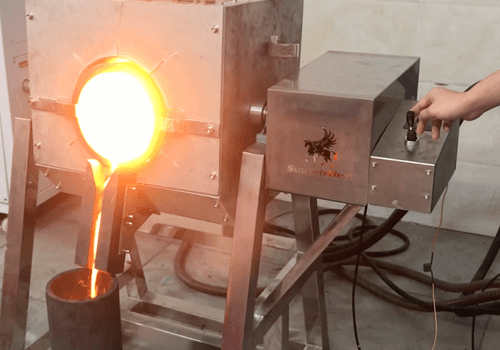
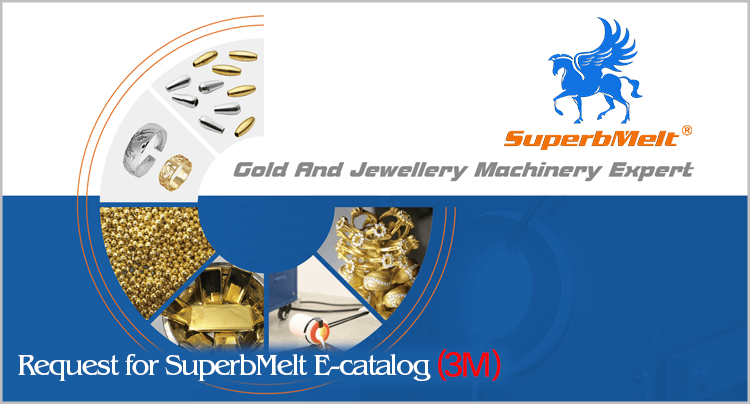
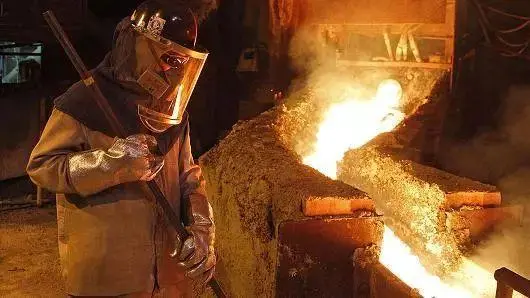


 © Copyright 2008-2021 Superb Electromachinery Co., Limited
© Copyright 2008-2021 Superb Electromachinery Co., Limited